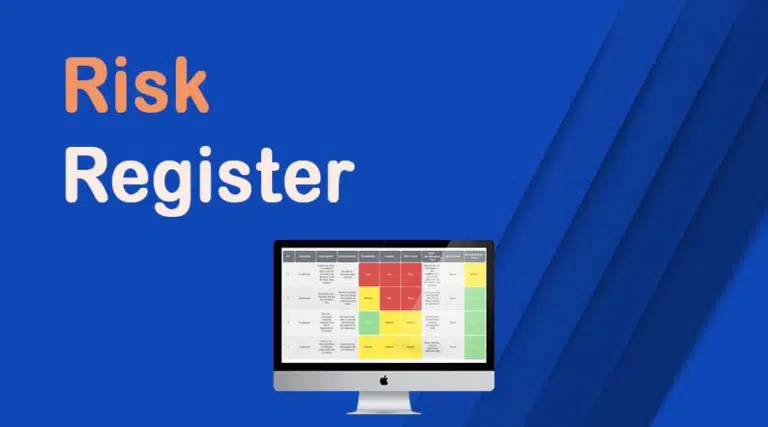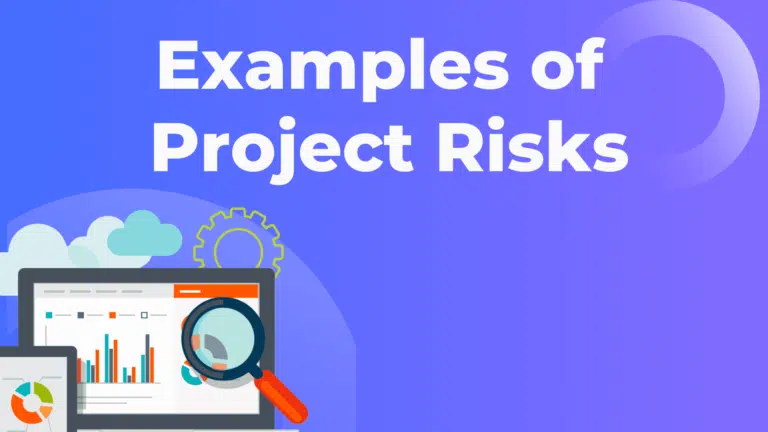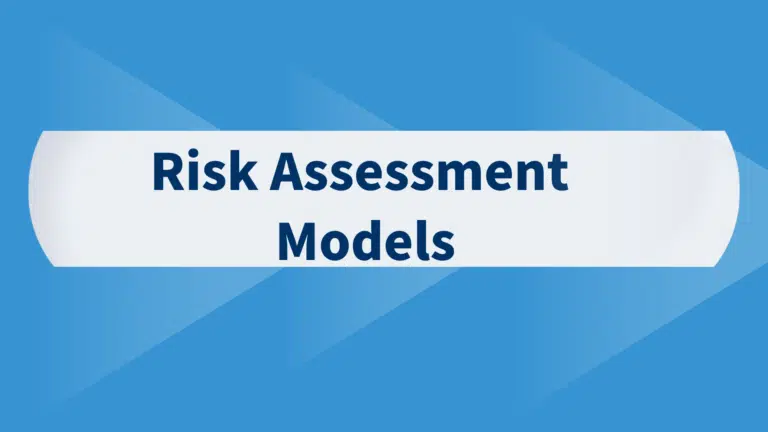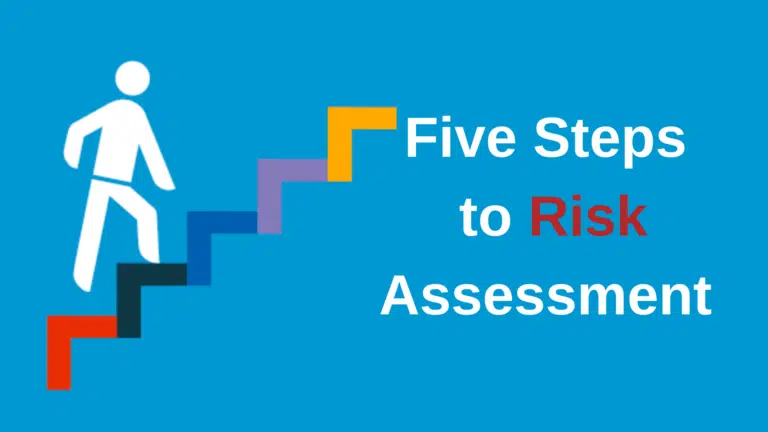Project management is a complex and time-consuming endeavor. It is challenging to track all project tasks while communicating with multiple stakeholders.
You have to consider many factors while developing your project plan. One essential factor is to create an issue log to help stay organized and keep track of problems that arise during the project’s lifecycle.
Before we move on to the issue log, let’s understand the issues first.
Issues are problems or complications that arise during a project and have affected the project’s objectives.
You can have many issues in project management, such as:
- Managing Stakeholders: This includes ensuring stakeholders’ needs are taken care of and dealing with conflict.
- Scope Creep: Scope creep occurs when the scope exceeds what was agreed. It mainly occurs due to miscommunication among stakeholders.
- Time Management: This ensures the project stays on track and meets milestones and deadlines. It ensures team members work on the right tasks on time.
- Resource Management: This ensures resource availability and efficient utilization.
Addressing issues requires dealing with them head-on.
Issue Log
An issue log is a project document, sometimes known as an issue register, that records problems in a project. It helps track what has been done and other relevant information about the issue. An issue log has information on all the issues that occurred during a project lifecycle, such as:
- Date and time of issue identification
- The severity of the problem
- Steps that were taken to resolve it
- Who is responsible for resolving it
- The expected resolution date
An issue log is a communication tool between team members to help identify potential problems before they become too serious.
An up-to-date issue log is an essential part of good project management.
The issue log should be updated regularly. This will help you keep track of changes or new issues that may have arisen and makes it easier to troubleshoot problems.
An issue log is a useful organizational process asset for future projects.
Some project management software applications include a built-in issue log, while others allow you to create a spreadsheet.
How to Manage Issues in Project Management
Project management involves dealing with issues. Project managers must handle any situation, whether it is an unexpected delay, a change in requirements, or something else.
An issue can be anything affecting the project goal. For example, an issue could be a delay in the testing stage of your product because one team member was sick. It’s essential to document every problem and solve them before they get worse.
An issue log contains all known problems, including their causes, effects, and resolutions. They have information about what happened, when it was discovered, and by whom.
Keep the following in mind regarding an issue log:
- The issue log should be accessible, simple, and easy to update.
- Be as specific as possible when documenting issues.
- Assign each issue a unique code for accurate tracking.
The best way to manage issues is by using an issue log.
Components of an Issue Log
At the basic level, an issue log records open or closed issues. It helps you keep track of the problem from the moment it is discovered until it is resolved.
You can classify and organize problems according to their type and severity for easier prioritization and handling.
An issue log has the following components:
- Issue Number: A unique number is assigned to each issue.
- Issue Name: A descriptive name is given to each issue. The name should be specific for easy identification.
- Issue Description: The description should contain a detailed explanation of the problem, including all relevant information, such as when it was discovered and the cause.
- Status of the Issue: This shows if the issue is new or old, resolved, not resolved, resolution, etc. You can see the issue’s status and progress in real time.
- Category: Include the type of issue in this section. This will help you classify and organize issues according to their types (i.e., network, performance, security).
- Priority: The priority level assigned to each problem helps determine which issues need immediate attention or if they can be dealt with later.
- Assigned to: This section is reserved for the person in charge.
- Target Resolutions Time-frame: When does the issue need to be resolved? This section sets time-based expectations for the team and stakeholders involved in fixing the problem.
- Resolution: If the issue is resolved, what was the resolution and measures taken? This section is helpful for future reference.
- Comments: In this section, you can add relevant notes about an issue. For example, if someone on the team is working on resolving it, you can add their name in this section.
Benefits of an Issue Log
The benefits of an issue log are:
- It provides a proper recording mechanism. In the issue log, team members can document problems they are experiencing with the project. This helps bring the right people to solve the problem.
- It ensures stakeholders are aware of the status of each issue. When issues are documented, stakeholders can see the status of issues.
- You can easily track the status of issues. An issue log shows the duration of the issue and what action you took to correct it. This information can help teams identify the root cause of each issue and develop a solution.
- It is a good communication tool. An issue log can help ensure that team members know what tasks they are responsible for and how delays can impact the project. You can track this information on a timeline or Gantt chart visually.
- It tracks any progress and problems in a project chronologically. It shows the overall progress and status of a project in one location. This information lets stakeholders see how each issue impacts other tasks within the same project.
- You can solve recurring issues with the least amount of effort. A well-maintained issue log helps identify recurring issues from past projects. This information helps you develop plans to prevent these problems in future projects.
- An issue log is a helpful lesson-learned document.
By tracking each issue and ensuring stakeholders are aware of the status, you can prevent the problem from escalating and keep projects on track.
Issue Log Example
Below is an example of an entry in an issue log:
- Issue Type: Security.
- Priority: High.
- Assigned to: Harry.
- Target resolution time-frame: Two weeks.
- Resolution: The password reset procedure was followed, and the issue has been resolved.
- Comments: The user contacted support, and they helped him reset his password.
- Resolved: This section is reserved when the item has been resolved or completed.
- Comment: Provided screenshots of how the user reset the password.
Here are example templates for an issue log:
Example 1:
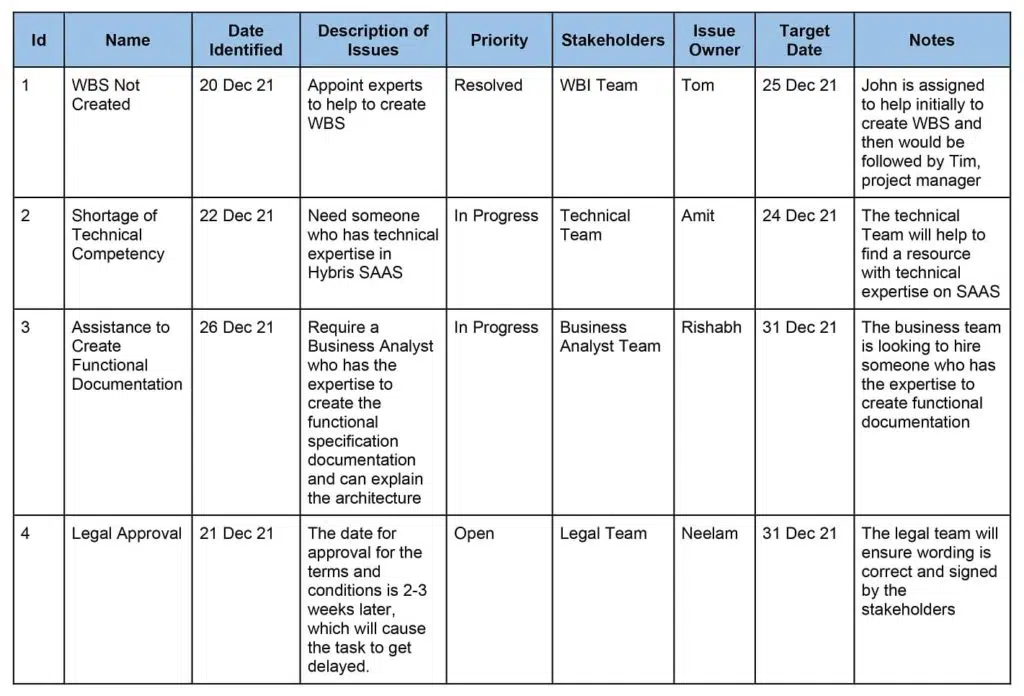
Example 2
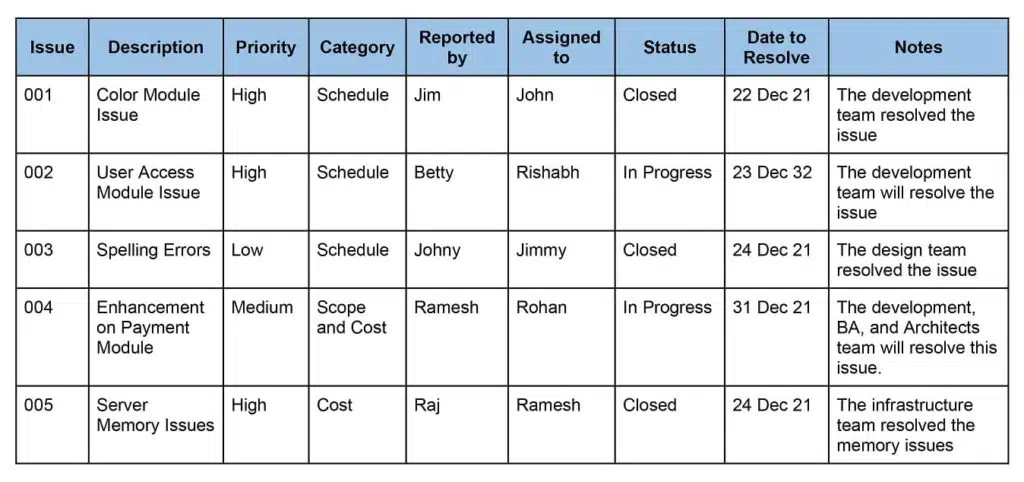
Issue Log Vs Risk Register
An issue log contains details on issues such as the date and time of issue occurrence, severity, how it was solved, who solved it, etc.
A risk register contains details on risks, such as the list of risks, their ranking, risk response plan, risk owner, watchlist, etc.
However, both are live project documents and are updated when new risks or issues are identified. Both are confidential documents as they can contain sensitive information and cannot be shared with everyone.
Issue Log Vs RAID Log
RAID stands for Risks, Assumptions, Issues, and Dependencies. Many projects have a RAID log instead of an issue log. The RAID log takes care of issues related to the project along with risks, assumptions, and dependencies.
The RAID log is also a project management document. If a project is using the RAID log, it won’t have an issue log.
The RAID log is an important tool. It helps stakeholders see project issues, risks, assumptions, and risks in one place at a glance.
Issue Log Best Practices
The following are best practices to get the most out of an issue log:
- Report Issues Immediately: Encourage team members to report issues as soon as they occur. Delaying an issue can escalate it and affect the project severely. Delaying can compound the issues, and then solving them will be difficult and time-consuming.
- Log Issues: You should log the issues accurately, and stakeholders must be aware of them. A well-maintained issue log makes it easier to manage issues.
- Accurate Description: Issues should be maintained with a correct and brief description so anyone reading for the first time can understand them. It helps stakeholders understand and solve the issues.
- Assign the Issues: You must assign an issue to an unbiased team member to monitor and address it. It ensures the issue is resolved and does not escalate further.
- Track the Issue: You must track the issue’s resolution progress and ensure it is resolved. Make sure the person assigned to the issue is monitoring the issue and is involved in solving it.
Conclusion
An issue log provides a list of problems that have occurred and requires resolution. It contains a list of all issues, impacts, and resolutions. If used correctly, the issue log brings transparency to the project, increases accountability among team members, and builds team members’ trust in each other.
Ensure that only relevant stakeholders have access to this project document, as it sometimes may contain sensitive information.

I am Mohammad Fahad Usmani, B.E. PMP, PMI-RMP. I have been blogging on project management topics since 2011. To date, thousands of professionals have passed the PMP exam using my resources.



